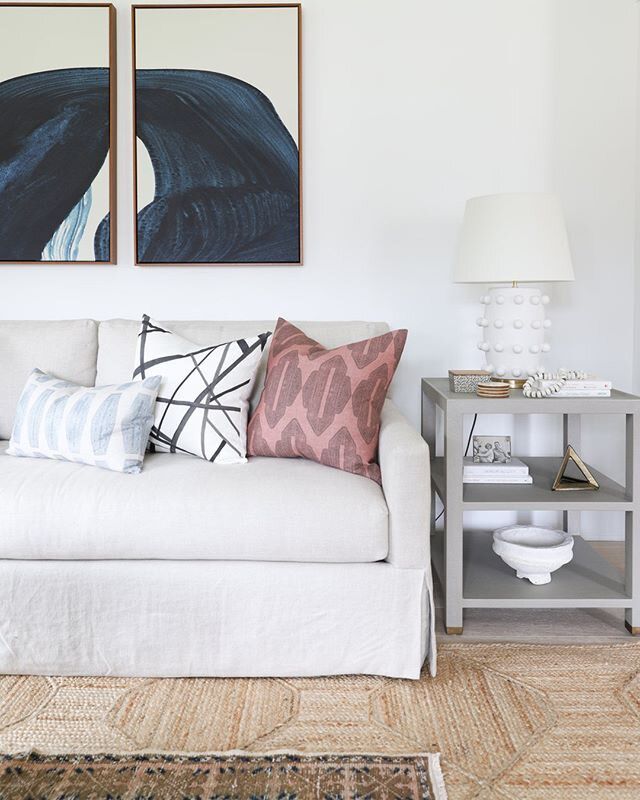Act as a native French speaker and an expert in Home Decoration, who speaks and writes fluently in French. Translate the article below into French. Make sure the translation is linguistically accurate, and conveying the meaning, facts and figures of the original text. Ensure the content is engaging and culturally appropriate for French readers. Don’t talk about Yourself or Your Experience. Don’t Self-reference. Don’t explain what you are doing. The article to translate:
Love them or hate them, there’s no denying that throw pillows make a sofa look inviting. But exactly where is the line between a cozy number of throw pillows and an inconvenient, excessive amount?
Two experts weigh in on a few golden rules to keep in mind when adorning your couch, and exactly what is the right number of throw pillows for a comfy yet stylish couch setup.
The Answer: One to Three Throw Pillows in Each Corner

Design by Kate Marker Interiors / Photo by Emily Kennedy Photo
According to Los Angeles-based founder and principal designer of Design Hutch, Brooke Spreckman, the answer for how many throw pillows you should have depends on number of corners on your couch.
“I usually mix it up and have about two or three, depending on size, per corner of each sofa or sectional,” Spreckman says. Sometimes one is acceptable if the pillow is big or the sofa is shallow.
For example, if she is accessorizing a three-corner sectional with throw pillows, she often places two larger throw pillows at each of the two corners where the back of the couch meets the arms. Then, in the third corner (the one in the middle), she places two medium-sized pillows and a small throw pillow for a total of seven pillows on the entire sectional.
Based on Spreckman’s guidance, a couch with only two corners (one on each end) could have between four and six pillows.
Jess Onorato, head of product and design and in-house interior designer at Habitat Home & Garden, shares her golden ratio for throw pillow groupings.
“As a rule of thumb, we style our accent pillows in groupings of three [with] one 22×22-inch, one 20×20-inch, and one smaller 14×20-inch lumbar,” she says. “If the style of the sofa is something to showcase, we recommend scaling the pillows down to one square and one lumbar. Alternatively, if we are working with a large sectional sofa, we may want to add in a long 14×36-inch lumbar.”
The Size and Style of the Sofa is a Factor

Design by Emily Henderson Designs / Photo by Tessa Neustadt
Spreckman also considers how many people the sofa can seat when choosing a throw pillow collection. On a standard three-seater sofa, she adds between three and six throw pillows depending on the size of the throw pillow and the sofa’s depth.
“If you have a very narrow sofa, without much seat depth, you really don’t have the room to add that many throw pillows, as it’ll make the seated area too shallow,” she says. “Don’t forget, you will also need a place to sit.”
But on a super deep sofa, more pillows are needed because you need the extra support from the throw pillows, Spreckman explains.
According to Onorato, the sofa’s style plays an even bigger role in determining the best number of throw pillows.
“While the size of a sofa is typically a good way to gauge the number of appropriate pillows, it is more important to consider the style,” she says. “A French settee, for example, would prefer to be showcased as is, while a track arm or square arm would be more inviting to several groupings of throw pillows and throws.”
In Some Cases, Zero Throw Pillows Is Best

Throw pillows aren’t for everyone. If you often find yourself tossing your mix of throw pillows out of the way before lounging, or you’re trying to hone a minimalist look, you can always go with no pillows. Spreckman notes that a tightly upholstered sofa back with a decorative back rather than loose cushions tends to look great without any throw pillows.
“Throw pillows are technically there for lumbar support, so it’s helpful to have them when needed, but if you have a sofa that is more formal for seating and the back on the seat sits you up properly without having any throw pillows, then they’re not always necessary,” she says.
Onorato also agrees with the less-is-more sentiment in certain situations. “Styling is dependent on the spatial surroundings, and a sofa design can often be the statement of the room,” she says. “Beautifully sloped arms or a tufted sofa would be hidden by the use of accent pillows, so we consider using a textured or patterned throw to honor the sofa design.”
Additional Tips for Sofa Styling
It’s not always how many throw pillows and different throw pillow covers you choose, but sometimes which ones you select that has the biggest impact on your sofa’s overall design scheme.
“Incorporating varying textures through accent pillows and throws is a beautiful way to add depth and warmth to a home,” Onorato says. “Colors, patterns and textures are key elements for designing with throw pillows. Consider mixing linen, cotton, woven, and velvet.”
Additionally, Spreckman notes that you should keep balance in mind when placing throw pillows in each corner.
“I always like to ensure that each corner of my sofa reflects one another, in one way, shape, or form,” she says. “I like to give each corner the same type of throw pillow and then layer it in so that there is some variation between them all, and so they can still bounce off between each other.”




